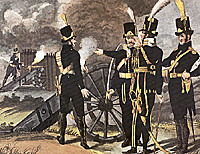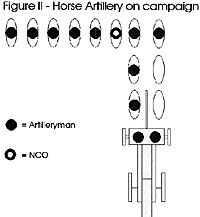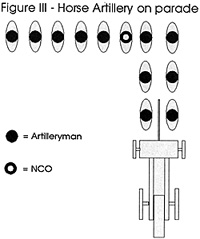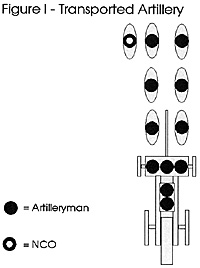ORGANIZATION
The Regiments
In 1794 the Royal Regiment of Artillery consisted of 40 companies of foot artillery and one brigade of horse artillery. On 26th May 1794 the regiment was divided into four smaller regiments.

Large Illustration (slow: 159K)
The Svea (Swea) Artillery Regiment was formed from the 13 companies located in and around Stockholm.
The Gota (Gotha) Artillery Regiment was formed from the eight companies of the Royal Artillery located in Gothenburg, Karlstad and Jonkoping. In 1801 the regiment was increased to 16 companies, by the merger with Gothenburg's garrison regiment (Stedingska).
The Vendes (Wendes) Artillery regiment was formed from the horse artillery brigade and the eight companies located in Skane and Swedish Pommerania. In 1797 the horse artillery was converted to foot, but a new horse artillery company was formed in 1802 and by 1806 there were two. In 1811 three companies of the Finnish Artillery Regiment were transferred bringing the strength up to 12 companies. A large portion of the regiment formed the garrison of the fortress of Kristianstad.
The Finnish (Finska) Artillery Regiment was formed from the 11 companies located in Finland. In 1810, after the loss of Finland to Russia, this regiment was disbanded.
The 1802 Artillery Committee
In September 1802 a committee was formed to study and report on the organization of the artillery, especially the horse and foot artillery, a task which it completed in 1807. It was realized that artillery should be as mobile as possible, and some of the major changes that it introduced in order to achieve this aim were:
-
1. A new type of limber with storage for ammunition and capable of
being ridden by two or three artillerymen (similar to that used by
the British).
2. Better and lighter pieces were designed. Some ideas were borrowed from the French Gribeauval system. The artillery would concentrate on 6-pdr and 12-pdr guns and 8-pdr (6") howitzers. The 3-pdr guns would be phased out.
3. The limber drivers would no longer be just train-troops, but would be trained artillerymen.
4. There would be three types of artillery: horse, field and garrison. Horse artillery would have all the gunners mounted, but as this was far too expensive for more than a couple of batteries, the remaining field artillery would have the gunners transported on the draught-horses, limbers and guns in a fashion similar to that used by the Austrian "wurst" batteries. There would not longer be any foot artillery batteries.
These reorganizations were first tested in the 1805-07 campaign in Germany.
The Companies
Each artillery company was commanded by a captain, and had two officers, five NCOs, five bombardiers, 75 artillerymen and a trumpeter. When a battery was formed for a campaign, it was usually formed by taking men from two companies of the same regiment. This allowed the battery commander to take just the best men, and leave behind those too old or too green to campaign. It was one of the reasons behind the high quality of the Swedish batteries.
Horse Artillery Batteries:
According to the regulations, the horse artillery was formed into batteries of six pieces each. The battery was divided into three divisions each of two pieces. The personnel should consist of four officers, eight NCOs, one trumpeter, one surgeon, one farrier, 81 bombardiers and artillerymen as well as 24 train drivers, a strength of 120 officers and men. There were 142 horses, of which 87 were battery-horses and 55 train-horses.
 Each gun-crew consisted of one NCO and 11 men.
Each gun-crew consisted of one NCO and 11 men.
The large number of train troops were required for the large wagon park which totalled 18 vehicles. One ammunition wagon per piece; one reserve ammunition wagon, one equipment wagon and one forage wagon per division; and one medical wagon, one supply wagon and one reserve limber for the whole battery.
At first all gunners had been mounted, but to save money, two gunners had their horses withdrawn and they then rode on the limber (fig II) except when on parade when they rode the two free draught horses (fig III).
 This organization was very similar to the RHA although a little weaker. Mercer at Waterloo had 193 officers and men with 226 horses for his six pieces, nine ammunition wagons and four other vehicles.
This organization was very similar to the RHA although a little weaker. Mercer at Waterloo had 193 officers and men with 226 horses for his six pieces, nine ammunition wagons and four other vehicles.
Field Artillery Batteries
Field artillery was formed into batteries of six pieces each. The battery had an organization of four officers, seven NCOs, 100 men, 103 horses and 17 wagons.
Each gun-crew, like that for horse artillery, consisted of one NCO and 11 men.
The NCO was mounted, and the 11 men rode; six on the draught-horses, three seated on the limber and two seated on the gun in Austrian "wurst" fashion (fig I).

UNIFORM
1794 Foot Artillery
The Royal Regiment of Artillery received new uniforms in February 1794. These consisted of a dark-blue double-breasted coat, with dark-blue facings, turnbacks, shoulder straps, cuffs and collar. Dark blue breeches and black cloth gaiters which came up to just below the knee were worn over black shoes. A waistbelt of yellow a blue cloth was worn at first, but this was soon replaced by a buff leather belt with a brass buckle.
The headdress was a black felt round Swedish hat with the brim extended on the left and turned up to the crown where it was fastened with a red and white cockade. Around the bottom was a brass hat band. Standing up from the cockade was a plume of yellow wool. The cockade was soon replaced by a yellow bow and loop. This hat remained unchanged until it was replace by a shako after 1808, except for the period 1802-05 when the plume color was yellow over blue.
In May when the artillery was split into four regiments, it was decided to give each regiment a distinguishing color, to be worn on the collar. This practice continued through-out the Napoleonic wars. These colors were; Svea Dark-Blue (unchanged), Gota Yellow, Vendes White and Finnish Red.
In 1802 the officers received single breasted dark-blue frock-coats with the regimental color on the collar. This they wore with dark blue breeches and boots. Just above the elbow of the left arm, they wore a white silk scarf tied in a band to commemorate the palace revolution of 1772. Their belt buckle was either of gilt with crossed cannon barrels or of the same model as the infantry which bore the Swedish coat-of-arms.
1802 Horse Artillery
In 1802 it was decided to reform the horse artillery which had been disbanded in 1797. The 1st (Liv) company of the Vendes artillery was reorganized as horse artillery. In addition to their existing uniforms, they received riding breeches of blue cloth and boots. Some even received a cloak of the same model as used by the cavalry. They soon received white plumes, to further distinguish them as elite troops. In 1806 the horse artillery, now two companies strong, received dark-blue trousers with leather on the inside of the crotch and ornamented on the front by two yellow loops. Officers trousers had gold hungarian knots and two gold stripes down each side. Officers wore gold aiguillettes and both officers and NCOs had gold grenades on their turnbacks.
1806 Changes
In 1806 it was decided that the artillerymen, like their officers, should have single breasted dark-blue jackets. These had ten buttons down the front. The field artillery also received trousers, under which short gaiters were worn.
1808 Horse and Field Artillery
In 1808 a thorough regulation was issued for the uniforms of the artillery, such that all artillery had the same basic uniform. It is unsure how long before items of this regulation were issued. It is unlikely that all artillery companies were so clothed until after the Russo-Swedish war 1808-09. Drawings from the 1813 campaign show this uniform in use.
Artillerymen: The jacket was to be dark-blue single breasted as currently used. The collar was to be of the regimental color, and should have a button-hole of yellow rope. Trousers were of dark blue with black leather all the way down the inside of the legs, and on the outside 12 brass buttons from the knee down. Over the shoes but under the trousers were buttoned short leather gaiters onto which were fastened the spurs. A cloak of the cavalry model was issued. The headdress was replaced by a French style shako. This was 22 cm high, made of black felt with an unusual all round black fringe hanging from the crown. The shako had a brass plate bearing two crossed cannon barrels, a yellow band at the top. A yellow cockade was worn on the left hand side above which was fastened a white feather plume in full dress. One English source states that the Gota Regiment had a hat with horse-hair crest of the same model as the grenadiers (see issue 5) but I can find no corroborating evidence in Swedish sources.
NCOs: The uniform was to be basically the same as for the men. The differences were pointed, instead of round, cuffs and button holes on the collar were of gold lace. The trousers buttoned up all the way up the outside of the legs and boots were worn instead of shoes.
Officers: The officers kept much of their previous uniform. The frock-coat now had pointed cuffs and two gold lace button holes were worn on each side of the collar. The trousers had gold embroidery on the front and buttoned over their boots. The shako was the same model as the mens, but had a fringe of silk and a gold braid band around the top. In full dress gold full epaulettes were worn by majors and above, and demi-epaulettes by captains and below. The white brassard and belt were unchanged although a general order discontinued the wearing of the brassard after the campaign of 1809.
Horse artillery: The same uniform was worn by the horse artillery with a few modifications, mostly carried over from the previous uniform model. Gold grenades were worn on the turnbacks of officers and NCOs. Instead of epaulettes, horse artillery officers wore gold aiguillettes on the left shoulder. Officers had two gold hungarian knots on the front of their trousers and two gold stripes down each side, while the other ranks had two yellow loops on the front.
Equipment
Belts: These were of buff leather for the NCOs and men. Officers belts were made of cloth and were either gold or blue edged with gold.
Weapons: Prior to 1807 the foot artillery were armed with a short sword of a model similar to that used by the grenadiers, and the horse artillery with light cavalry sabres. In 1807 these were replaced in both the horse and field artillery with light cavalry sabres purchased from England of model 1783. When mounted on limber horses, the artillerymen hung the sabre from the saddle, in front of their left leg and partly hidden by the shabraque. The horse artillery was issued two pistols per man, while the foot artillery were issued muskets of model 1778. When the foot companies were converted to field, they retained only enough muskets for guard and garrison duty. There was no officer pattern sword, and of the items still in existence, no two appear to be the same. Horse artillery officers appeared to have preferred sabres while officers of other batteries preferred straight swords.
Cartridge pouch: These had been worn by officers since 1779 and by NCOs and men since 1794. Initially these were of plain black leather, although from 1802 the officer's bore a gold metal badge. The badges were different for each regiment. The Svea artillery had the coat-of-arms of Svea (three crowns on a blue circle) inside a star. The Gota artillery had the coat-of-arms of Gota (a lion over three diagonal bars on a blue circle) inside a star. There is no existing example or good illustration of the badge worn by the Vendes artillery. Like the previous regiments, it was a gold star with a blue circle inside, but what device was born on the circle is uncertain. Probably it was the coat-of-arms of Vendes (a dragon and four stars). The Finnish artillery badge was the coat-of-arms of Finland.
EQUIPMENT
Swedish artillery equipment had woodwork of a greenish-blue color with black metal carriage fittings.
The howitzers used the archaic designation based upon the weight of a stone projectile which could have fitted into the bore. An 8-pdr howitzer would have a bore somewhere between that of the British 5.5" and the French 6" howitzers.
m/1792: Cardell designed a 6-pdr cannon and an 8-pdr howitzer for the Horse Artillery. These were made of brass and mounted on carriages of the double-bracket type. The gun had a range of 1200 m with ball and 400 m with canister. The range of the howitzer is given as 900 m. Four cannons and two howitzers formed a battery.
m/1805: As a outcome of the 1802 artillery committee, Helvig designed three field pieces made of iron; a 6-pdr cannon, a 12-pdr cannon and an 8-pdr howitzer. Like their predecessors, they were mounted on carriages of the double-bracket type. These pieces are often referred to as m/1805, but sometimes as m/1804 or m/1808. Although designed for the field artillery, one battery of horse artillery was equipped with six of these 6-pdr cannons during the 1813 campaign.
Limbers: The old A-frame limber was replace by a limber with storage for ammunition as a result of the 1802 committee. It was similar to that used by the British and was ridden by two horse or three field artillerymen. The limber could hold 54 rounds for a 6-pdr cannon or 32 for a 8-pdr howitzer.
Horses: The horses had an hussar saddle and a dark-blue hussar pattern shabraque edged with two yellow stripes. Even the riding horses were equipped with harness, and not just the draught animals. This would allow the riding horse of an artilleryman or trumpeter to quickly replace one of the team horses should it be killed.
REGIMENTAL ARTILLERY
One Finnish infantry regiment, the Savolax Jaeger Regiment, had an attached foot artillery company about which I can discover very little information. During the Russo-Swedish war of 1808-09 it was uniformed in the same style as the other artillery troops (hat and single breasted jacket), but its uniform was grey like that of the Savolax Jaegers. With this it wore grey breeches and short black gaiters. The company was issued with quantities of red and dark-blue cloth, and based upon these quantities it has been suggested that they had red collars, and dark-blue cuffs and turnbacks.
STANDARD
No standards or guidons were carried by the artillery during the Napoleonic wars, although one was later carried by the horse artillery.
On July 7th 1815, King Charles XIII issued a general order stating: "As the Royal Wendes Artillery Regiment on many occasions during the latest campaign in Germany, and especially during the engagements of Gross-Beeren, Dennewitz and Liepzig manifested a superb bravery, HRH has gracefully dedicated in perpetuity to the said regiment a standard of honor, which will always be carried by the regiment's horse artillery". The standard was presented on July 12th 1816, and bore the battle honors GROSBEHREN (sic), DENNEWITZ and LEIPZIG.
SOURCES
The Swedish Army Baron Fredrick Eben von Brunnen, published in London 1808.
Drakt och Uniform Erik Bellander
Kungl. Artilleriet, Det ridande artilleriet edited by J. Hedberg
Royal Army Museum Yearbooks especially numbers VIII, XI, XXIV, and XXXVIII.
Wendes Regemente 1813 Sveriges Forsvar Published by the Officers Corps edited by C. Kleen & E. K :son Bjorn
Swedish weaponry since 1630 B Holmquist & B Gripstad
Back to Table of Contents -- First Empire #13
Back to First Empire List of Issues
Back to MagWeb Master Magazine List
© Copyright 1995 by First Empire.
This article appears in MagWeb (Magazine Web) on the Internet World Wide Web. Other military history articles and gaming articles are available at http://www.magweb.com